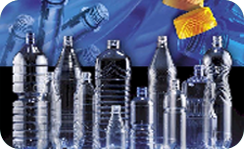NEW MOLD QUALIFICATION
Our goal is to run the best quality containers at the fastest average cycle time possible. I say average because it is not economical to run a process at a very fast time but have it stop every so often because the process window is too small. What we want is a stable process that does not require an operator's attention for a long time.
I assume you know how to adjust your machine. If not take one of my training courses!. So I will concentrate on the dimensional and procedural aspects of the process.
First we want to have a mold built that we can still tweak, i.e. we want the neck to be made material safe or smaller than we would expect it to be taking shrinkage into account. To save time we want all flash areas, i.e. areas that are cut away on the mold, to be wider than your mold maker wants them to be. At least that is my experience. I hate to send a mold back just to get the bottom flash area enlarged by 1", what a waste of time. It does not cost much to go to the maximum right away and then you will not have any problems.
Our head tooling, blow pin tips, cutting knife are of course all ready by the time the mold is in and a machine is available. We have 100 psi water pressure on the machine with the water at 50 to 55º F. Assuming that the head tooling is right, now run the machine until either one of these conditions occurs:
* Bottom or neck flash sticks. Examine mold drawing if cooling channels are optimal.
* Body wall shrinks to concave shape. If your mold maker has the capability, the mold can be compensated for this shrinkage: A grid pattern is drawn on the bottles and each point of the matrix is measured in depth. This information is then fed to a machining center that cuts the mold deeper by the same amounts. If this is not posible or too costly, you have to experiment with different cycle times and let the bottles sit for 2 days at 50% humidity to observe shrinkage before you make a final decision.
* Bottles are being deformed during the normal operation of the machine or while being packed. It is important that during sampling the bottles are processed as they will during production so that all problems come out at that time.
* Bottom of bottle shrinks down leading to a "rocker bottom".
Once you have determined the fastest cycle time, you can start measuring your neck dimensions after the bottles have sufficiently cooled down. If you have no time to let them cool down the 2 days that are optimal, assume that they will shrink another 0.001" to 0.002" from the point that they have cooled down to room temperature. Look for:
NEW MOLD QUALIFICATION
* All diameter dimensions, that is the "T", "E", and "I" dimension. If they are too small, the mold can be compensated for it.
* The "H", "L", and "S" depth. Compensation here can be done on the striker plate or the neck insert.
* Ovality. Neck inserts can be compensated for ovality but you should investigate the reasons for ovality first. Often the neck cooling is insufficiently close to the parting line ("horseshoe design") or the blow pins were not adjusted properly or there is a cooling problem there. Other reasons can be a clamp that is opening or deformation happening after the molding in the take-out tooling. Ovalized parisons also contribute to neck ovality.
Once you know how much compensation you need, take into account what water temperature you were running and then decide if you want to have the mold corrected all the way or leave a few thousands just in case.
Let's go through an example:
We will focus on the T-dimension of a 24SP410 neck. This neck will have a target T-dimension of .932" +- 0.008". The mold might be ordered at 0.957" on the parting line which allows for 2.6% shrinkage and 0.949" 90º to it. This will compensate for less mold cooling at the parting line.
After you made the initial samples, the average T-dimension is 0.928" at the parting line and 0.921" 90º. This would indicate that the mold was overall a little too small but also over-compensated at the parting line. The quickest fix is to open the T-dimension by 0.004" on the parting line and by 0.011" 90º. After the mold was modified, you need to run another qualification test and get your bottles approved. Make sure that all machine parameters are the same.
If you have any questions regarding this procedure, please comment below.

 The experts at Apex Container Tech Inc. are here to assist you in your current business or with starting a new one
The experts at Apex Container Tech Inc. are here to assist you in your current business or with starting a new one
 The experts at Apex Container Tech Inc. are here to assist you in your current business or with starting a new one
The experts at Apex Container Tech Inc. are here to assist you in your current business or with starting a new one









